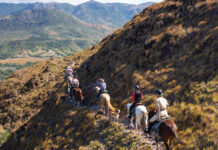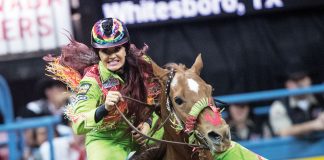| About the Author Kim and Kari Baker are identical twins who raise Appaloosas on their Montana ranch. |
Cowboy Mounted Shooting is an exciting blend of exhibition style Wild West shooting and a form of gymkhana. In this sport, you must skillfully rein your horse through a setup of 10 balloons or course of fire. Sound simple? Then add the task of cocking and firing a gun, holstering it then drawing a second revolver, as you and your horse travel through a course of balloons and barrels. Additionally, you and your horse will be timed and so must perform the task at a respectable speed. Each missed shot will add an additional five seconds to your time, as will a tipped barrel. This event is tougher than you might think. In fact, the demands on both horse and rider are much more than they first appear.
If you’re not already familiar with handling firearms and horses at top speed, this is probably not the sport for you. Training your horse to accept the sound of gunfire and the sight of balloons can be dangerous, so assess your skill and comfort level before you decide to pack a pistol and mount up.
How to Play
Each rider, clad in 1800s period western dress, carries two .45 caliber single-action revolvers loaded with black powder blanks and rides an established course that consists of two sets of five balloons.
Gun in hand you’ll charge across the starting line at a fast lope and proceed to target the first five balloons. This first set of balloons will challenge your ability to skillfully rein your horse along an indirect route. With over 70 existing patterns, line of travel will vary from serpentines to circles as horse and rider maneuver through gates and around barrels.
Immediately after the fifth shot is fired, you’ll holster the now empty revolver and draw the second revolver as you round the end barrel. The second set of five balloons is often placed in a straight line on a direct route to the finish line. Called the run-down, you’ll shift your horse into high gear at this point. The tricky part here is that you must not go faster than you can adeptly work the gun.
The Shootist
Unlike most other equine events where only riding skills are judged, the upshot of this competition is also aimed at the rider’s shooting skills.
The Cowboy Mounted Shooting Association (CMSA) has created a class ranking system that’s based on the competitor’s riding and shooting abilities. Competition for men, ladies and seniors are each categorized into five levels. Everyone begins at the entry level and must meet specific prerequisites to move up through each preceding class level.
Juniors aged 12 to 15 years share the same ranking system as the adults, but a special Wranglers Class exists for kids under 12 years of age. They ride the same set course of balloons as the other contestants, but do not shoot a gun while on horseback. Once they’ve completed the pattern on horseback they are then allowed to shoot five balloons under adult supervision while standing on the ground.
The Horse
While nearly all horse breeds are suitable for cowboy mounted shooting, stockhorse breeds dominate the field. “Bloodlines aren’t as important as the horse’s athletic ability or attitude,” says long-time trainer and mounted shooting clinician, Larry Townsend, of Townsend Ranch, near Darby, Mont. “Mounted shooting is very hard on the stability of the horse. Keeping your horse calm yet competitive is tough, and the more competitive you are the more difficult it is.
“Your horse should be sound and in good physical condition as well as able to handle up to four wide-open runs in a single day’s event. He also needs to be very well trained,” Larry adds. Just as in any other equestrian sport, the better the horse is able to respond to basic rein and leg cues, and speed control, the more successful you’ll be.
| Resources: Cowboy Mounted Shooting Association Single Action Shooting Society |
Training Methods
There is no set rule on how to go about training your horse to become a competitive mounted shooting horse. In fact, there may be as many training techniques as there are trainers. But before bringing out the heavy artillery, your first consideration is your horse’s well-being.
“The first step I take in training a horse to tolerate gunfire is to teach him to accept earplugs [designed for horses],” says Larry. It’s imperative that your horse not be ear shy. Once he is comfortable with his ears being touched all over, inside and out, introduce him to the earplugs, which will cut down the noise he hears from the loud gunshots.
“We put the horse in a safe environment then put the earplugs in his ears. Even though he’s used to having his ears handled, he’s likely to shake his head in an attempt to dislodge them. You can stand by patiently, replacing the earplugs each time the horse shakes them out [until he gets used to them].”
Once your horse tolerates the earplugs you’re ready to commence shooting.
One method of training your horse to accept gunfire is to work your horse at one end of an arena, while at the other end of the arena a helper fires off a gun loaded with blanks. Rather than trying to restrain your horse, allow him to speed up if he needs to, then bring him back to a walk and have your helper shoot off another round. As your horse becomes used to the sound of the gun, begin working in circles at the center of the arena until you are satisfied with the results, then progress to the same end of the arena as your helper.
The next step is for you to handle the gun yourself. Once your horse tolerates gunfire shot from off his back at a walk, you can begin to speed things up. First at a trot, then lope and finally at a gallop. If he becomes overly excited when the pace quickens, transition down before advancing again in speed.
While most trainers use the above method, or a version of it, the same results are obtainable even out riding the trails. “I take my single action Colt .45 with blanks on a ride in the mountains. After a few hours of riding I find a long ridge and put my horse into a lope. When my horse starts to tire, I break him down to a walk and shoot a round. If he reacts to the gunfire, I lope him longer, then break down to a walk and shoot again. I continue this until he doesn’t react to the gunfire at a walk. After a month of this I shoot at a trot, then the lope, always looking for the same desired result,” explains Larry.
“Any exposure to the sound of gunfire is extremely helpful,” Larry says. Many prefer to start off with their horses loose in a pasture or corral where the horses are free to move at liberty. Another choice is to begin with therelatively quiet pop of a cap pistol, then progress to .22 blanks and finally graduate to the louder .45 Colt blanks used in CMSA competitions.
Balloon Blowout
To avoid a blow up, you’ll have to inflate your horse’s confidence around balloons. While the actual popping of the balloons shouldn’t bother a horse that has been trained to accept gunfire, the sight of these eerily floating orbs still may upset him.
When first introducing your horse to balloons, do it in a safe area and manner.
Begin with a balloon that is about one quarter filled with air. Once your horse remains relaxed when you touch him with the balloon, and he doesn’t react badly when it’s waved or batted around him, your next step is to fill the balloon with more air. At this point he has learned to accept a single balloon while being handled, but he needs to accept them in numbers. Now is your chance to decorate your horse’s barn, corrals or paddocks with a colorful bouquet of bobbing balloons.
OK partner, now that you and your horse are all geared up and ready for action, it’s time to mount up and burn some powder. Here’s hoping you get a drop on those ornery desperadoes you’ve been trailing and you’re quicker on the trigger.
This article first appeared in the September 2004 issue of Horse Illustrated magazine. Click Here to subscribe to HI.






See this event every year at the Hoosier Horse Fair and Expo and hope to get involved with it this year or the next with one of my horses